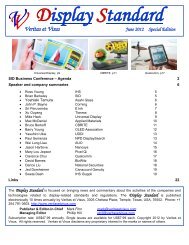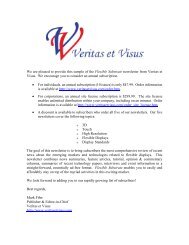You also want an ePaper? Increase the reach of your titles
YUMPU automatically turns print PDFs into web optimized ePapers that Google loves.
<strong>Veritas</strong> <strong>et</strong> <strong>Visus</strong> <strong>Display</strong> <strong>Standard</strong> February 2009<br />
notebooks, to very popular acclaim, and less than a year after that, Dell’s customers were indeed asking for wide<br />
aspect ratios. But rather than leading the mark<strong>et</strong> to wide aspect ratios, Dell was one of the last major PC companies<br />
to introduce a notebook PC with a wide aspect ratio display.<br />
It should be noted that my efforts at Dell to popularize the notion of displays at a 16:10 aspect ratio were not<br />
entirely unique ideas. Other concurrent efforts included:<br />
� Apple’s 22.0-inch Studio <strong>Display</strong> was introduced as an extension of the SXGA (1280x1024) form<br />
factor, widened to 1600x1024 (a 1.56 aspect ratio). Apple also introduced a notebook using a 15-.2-inch<br />
display at a 15:10 aspect ratio, (3:2), in an effort to sustain the x-axis of a 14.1-inch display (4:3). Apple<br />
also claimed advantages with the 3:2 format since it is the same as DVDs (720x480). As the 16:10<br />
aspect ratio gained popularity, Apple switched over to a 16:10 solution for all of its notebooks and<br />
monitors by 2005 – becoming the first PC company to exclusively offer wide aspect ratio displays.<br />
For both their Studio <strong>Display</strong> and their PowerBook G4, Apple chose to keep the y-pixel count unchanged from that of<br />
a more typical aspect ratio. For their 22.0” Studio <strong>Display</strong> at 1600x1024, this meant widening the x-dimension from<br />
a 5:4 ratio, creating a unique 25:16 aspect ratio. For their 15.2” PowerBook G4 display, they chose to widen the xdimension<br />
from a 4:3 ratio to another unique solution, this time to 1152 pixels and a 15:10 aspect ratio.<br />
� In 2002, NEC introduced a notebook with a 15.3-inch display at 1280x768 pixels, (a 15:9 aspect ratio).<br />
In 2005, HP made a big push to introduce 14.0-inch panels at 1280x768 pixels. Both of these efforts<br />
were doomed to failure – NEC’s engineers were chartering new ground a lone effort that got little<br />
popular support; HP’s engineers simply made a gross mistake, as the 16:10 precedent was already<br />
obvious – with the 16:10 solution trumping the 15:9 solution in almost all scenarios.<br />
� Sony, Fujitsu, Sharp, and Toshiba all introduced “sub-notebooks” with wide aspect ratios in the early 2000s<br />
at a vari<strong>et</strong>y of panel sizes and aspect ratios.<br />
Sony’s 8.9-inch portable PC at 1024x480 pixels; Fujitsu’s 8.8-inch solution at 1024x512 pixels; Sharp’s 7.1inch<br />
screen at 800x480 pixels; Toshiba’s Libr<strong>et</strong>to 1100 with a 7.1-inch display at 800x480 pixels; Toshiba’s<br />
Libr<strong>et</strong>to L1 with 10.0-inch panel at 1280x600 pixels. These wide-aspect ratio – “sub-notebooks” were all<br />
introduced in the period from 2000 to 2002.<br />
� IBM introduced their 22.0-inch T221 display in 2001 at 3840x2400 pixels – the first commercially<br />
available display at a 16:10 aspect ratio.<br />
7






